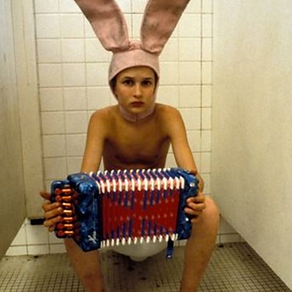
IRREVERSIBLE
Proust once wrote that "we are at times too ready to believe that the present is the only possible state of things." He believed that the fundamental purpose of art was to get us to re-examine the most basic of our truths, experiences, and surroundings; examining these with sensitivity and innovation, and communicating them, this was the purpose of an artist.
Gaspar Noe's haunting film Irreversible follows this artistic philosophy to its extreme, creating a work of art that is as stimulating as it is nauseating, as introspective as it is brash, and as poetic as it is pulpy. However, it is one that pushes the realm of what art can do into unchartered territory, and leaves an indelible mark on the history of the medium.
With its attenuated use of narrative, often incomprehensible and confusing ambiance, and an inescapable sense of nihilism and despair, Irreversible forces viewers to think deeply about the fragility of our lives, the loss of innocence, acts of violence, and social and psychological strife by way of profound cinematographic shock. The nature of time and actions is that they cannot be reversed.


In chronological order, the events of the film are as follows: lead Marcus (Vincent Cassel), and his girlfriend Alex (Monica Bellucci) attend a party, until an argument forces Alex to leave the party by herself. On her way home via a subway tunnel, she is accosted and then raped and beaten by a pimp. Marcus leaves the party and sees the destruction wrought upon Alex's body as she is loaded into an ambulance, deformed and unconscious.
Understandably devastated and running on the vestiges of alcohol and cocaine, Marcus sets out to find the culprit. The film opens with what would be the climax in a conventional narrative form, the aftermath of the group beating the suspected perpetrator to death inside a nightclub.
The film is told in reverse to drive home the inevitability of events, both within the film and within our collective lives. There is no room for the viewer to hope for retribution or escape, as Gaspar Noe purposefully inverts classic cinematic expectations of redemption. Trapped in the amber of time, the scenes where we learn of the loving relationship between Alex and Marcus set in an innocent and middle-class context take on added importance.



Knowing the fate that befalls both of them, we see Marcus, not as a vengeance stricken maniac, but as a tender lover, and Alex not merely a romantic partner or as an object of nearly mythical beauty, but as a fierce fighter befallen by tragedy. The structure of the film affords their love and innocence a deep richness. The viewer already holds the knowledge of their fates that will permanently alter both of them, physically and spiritually.
Gaspar Noe successfully creates an ambiance of weighty unease throughout the film. It is in the creation of this atmosphere that the ambition and drive in his filmmaking are palpable; the film's feel of jittery and hovering doom does not abate. Composed by the Thomas Bangalter of Daft Punk, the film's soundtrack rides waves of industrial-style electronic music, interchanging music with a low-frequency noise engineered to stir nausea and anxiety in its audience.
This soundtrack, almost akin to a dull migraine, is the ambient compliment to the film's chaotic, unscripted dialogue. The improvised and profane conversations are difficult to hear and even harder to understand; they recall feelings of authentic confusion and chaos. Noe intentionally removes any sense of cinematic orchestration, and the result is a deeply edgy and agitating film from open to close.
The camera work matches the unsettling score and acoustics of the film, the majority of which was done by hand. Irreversible is shot on a widescreen lightweight Minima Super16mm Camera, and it consists of only 12 takes for the entire film.






If watching the cinematography in a Hollywood Blockbuster feels like a Xanax, Irreversible feels Methamphetamine. The movements of the camera are violent, sharp, and physical, and they force the viewer to only concentrate on what is happening within the frame. The unflinching, unbroken and turbulent depictions of violence are the polar opposite of the stylized depictions in a mainstream film; there is no cathartic release, and there is no exploitation or dramatic indulgences.
Critics of Gaspar Noe have focused primarily on the graphic violence and ostensibly nihilistic philosophy operating within Irreversible. Others have lauded him as a genius, illuminated psychological landscapes within the human condition that film had yet to explore; the artistry transcending the vile details. Roger Ebert argued that the film's narrative structure makes it inherently a moral film; presenting the vengeance before the actions that ignite it, viewers are forced to process the vengeance itself, and then later think of its implications.
What is incontestable is that Irreversible is one of the most visually and substantively challenging films ever released, and its depictions of violence some of the most realistic possible. In a world where most of us see millions of murders on screen before we leave high school, perhaps there is utility in trying to understand violence and its repercussions in a brutally authentic way. It has been said that despite what it may pretend, pornography at some level argues for what it shows. One thing that Irreversible is not, is pornography.

Boundaries of what 'art' is get pushed by artists like Gaspar Noe. It is inevitable that in forging out new artistic space to explore and understand violence and morality, the execution will not be clean and flawless. Distinctions of what has merit, and what is indefensible are always in the eye of the beholder. Where exactly this line is demarcated is an argument as old as time itself, and one that will never be settled.

text: Aaron Gray
Recommended For You

